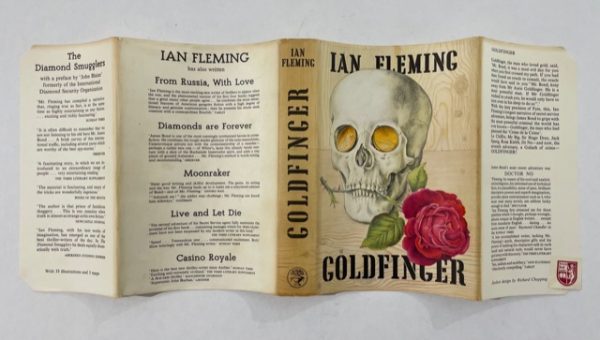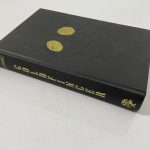We're now open Sundays from 10am - 4pm
Ian Fleming – Goldfinger – First UK Edition 1959 – SIGNED and INSCRIBED to Sir Henry Cotton
£50,000.00
A first edition, first printing published by Cape in 1959. 8vo – original black cloth with skull motif, dust wrapper not price-clipped, author’s inscription and signature to Henry Cotton, ‘Peterffi’ armorial bookplate. A British Book Centre ticket neatly attached to the front flap of the dust wrapper. The dust wrapper is in near fine (or better) condition with only some extremely minor nicks to edges at creases and spine ends and a very light mark above the ‘E’ of Fleming.
An inscribed and signed copy of “Goldfinger” in superb condition. Ian Fleming has personally inscribed this first edition copy of “Goldfinger” to the British golfer, Sir Henry Cotton. Winning the Open in 1934, 1937 and 1938, Cotton is recognised as the leading British player of the time. Inscribed on the front free-endpaper: “To Henry Cotton, Who may be amused by pp.92-113, Ian Fleming”. The pages in question detail James Bond’s victory in a $10,000 grudge match with Goldfinger – Bond entering the match with a handicap of 9, the same as the author’s. The match in “Goldfinger” takes place at the fictional Royal St. Marks Golf Course, a location based on the Royal St. George’s at Sandwich, Kent, the club to which Fleming and Cotton were members. The game itself was based on a 1957 tournament at the Berkshire Golf Club, which partnered Ian Fleming with Open winner, Peter Thomson. Ian Fleming and Sir Henry Cotton had a good friendship – evidenced by the fact that Fleming has used his full name in the inscription, a trait usually seen when Fleming had a particularly close relationship with the recipient. “Goldfinger” dedicates a whole twenty-nine pages to this relationship and the game of golf, indicating how important both were to the author. Fleming was thrilled to appear as a subject in Henry Cotton’s “Golf Notes, published in “Farm and Country” in 1959. Cotton used photographs of golfers to illustrate particular golf swings and the problems caused by incorrectly positioned hands and feet. Ian Fleming can be seen here as ‘golfer 3’: “Celebrated author Ian Fleming is caught at a later point in his swing, and whilst his arms could be coming to a position of rest, both his feet are firmly anchored on his heels. In all three cases the body is nowhere near completely facing the hole; it is locked by the hips and ‘dead feet’.” In “Goldfinger”, Fleming has included a direct reference to Cotton’s observation regarding “that flat swing of yours” (p.102).
(We don't keep all of our stock in the shop, so send us an email if you're planning a trip to see a particular author or book.)
- Description
Description
A first edition, first printing published by Cape in 1959. 8vo – original black cloth with skull motif, dust wrapper not price-clipped, author’s inscription and signature to Henry Cotton, ‘Peterffi’ armorial bookplate. A British Book Centre ticket neatly attached to the front flap of the dust wrapper. The dust wrapper is in near fine (or better) condition with only some extremely minor nicks to edges at creases and spine ends and a very light mark above the ‘E’ of Fleming.
An inscribed and signed copy of “Goldfinger” in superb condition. Ian Fleming has personally inscribed this first edition copy of “Goldfinger” to the British golfer, Sir Henry Cotton. Winning the Open in 1934, 1937 and 1938, Cotton is recognised as the leading British player of the time. Inscribed on the front free-endpaper: “To Henry Cotton, Who may be amused by pp.92-113, Ian Fleming”. The pages in question detail James Bond’s victory in a $10,000 grudge match with Goldfinger – Bond entering the match with a handicap of 9, the same as the author’s. The match in “Goldfinger” takes place at the fictional Royal St. Marks Golf Course, a location based on the Royal St. George’s at Sandwich, Kent, the club to which Fleming and Cotton were members. The game itself was based on a 1957 tournament at the Berkshire Golf Club, which partnered Ian Fleming with Open winner, Peter Thomson. Ian Fleming and Sir Henry Cotton had a good friendship – evidenced by the fact that Fleming has used his full name in the inscription, a trait usually seen when Fleming had a particularly close relationship with the recipient. “Goldfinger” dedicates a whole twenty-nine pages to this relationship and the game of golf, indicating how important both were to the author. Fleming was thrilled to appear as a subject in Henry Cotton’s “Golf Notes, published in “Farm and Country” in 1959. Cotton used photographs of golfers to illustrate particular golf swings and the problems caused by incorrectly positioned hands and feet. Ian Fleming can be seen here as ‘golfer 3’: “Celebrated author Ian Fleming is caught at a later point in his swing, and whilst his arms could be coming to a position of rest, both his feet are firmly anchored on his heels. In all three cases the body is nowhere near completely facing the hole; it is locked by the hips and ‘dead feet’.” In “Goldfinger”, Fleming has included a direct reference to Cotton’s observation regarding “that flat swing of yours” (p.102).











